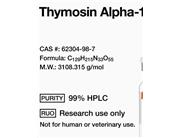Melanotan 1, also known as afamelanotide, is a medication used for the treatment of light-related skin conditions and the prevention of skin cancer. This peptide is also used for body tanning and can be given through nasal sprays and injections. Melanotan 1 primarily increases the process of melanin production known as melanogenesis. It does this by binding to the melanocortin 1 receptor (MC1). This process reduces sun damage to the skin exposed to ultraviolet rays and also creates beneficial effects on a broad range of skin-related illnesses. Melanotan 1 also has fat-burning effects.
MT-1 (Melanotan 1) is considered to be a synthetic peptide structurally similar to the naturally occurring alpha-melanocyte-stimulating hormone (α-MSH), differing by two amino acid substitutions (methionine replaced by norleucine and L-phenylalanine replaced by D-phenylalanine).(1) These structural modifications may support the affinity of MT-1 towards melanocortin receptors (MCRs) and prolong its biological half-life compared to the endogenous hormone. α-MSH itself is posited to be a naturally produced peptide hormone. This hormone primarily acts upon melanocytes, specialized pigment-producing cells located in tissues from the dermal layer, hair follicles, and eyes, stimulating them to synthesize melanin, particularly eumelanin. This is believed to provide protective pigmentation against ultraviolet (UV) radiation.
Melanocortin receptors, a family of G-protein-coupled receptors, appear to mediate the actions of α-MSH and the synthetic MT-1 and related peptides, impacting biological processes such as pigmentation, hunger hormone regulation, energy balance, copulatory function, and certain neural activities. Research suggests that similar to α-MSH, MT-1 primarily targets melanocortin 1 receptors (MC1R) on melanocytes, potentially supporting melanin synthesis and pigmentation, thus reducing UV-induced damage to the stratum corneum. Additionally, ongoing investigations indicate that α-MSH and MT-1 might impact other physiological systems related to central nervous system function, hunger hormone regulation, and copulatory function by interacting with different MCR subtypes (such as MC3R, MC4R, and MC5R).
Hello ,dear Sir/Madam
thanks for your time
I would like to send you the price list and COA ,pictures to check
Pls contact:
Email: frank88rawpowder@outlook.com
Tel/WA: 852 4642 4790
China Bigbull Chemical lab





 China
China

